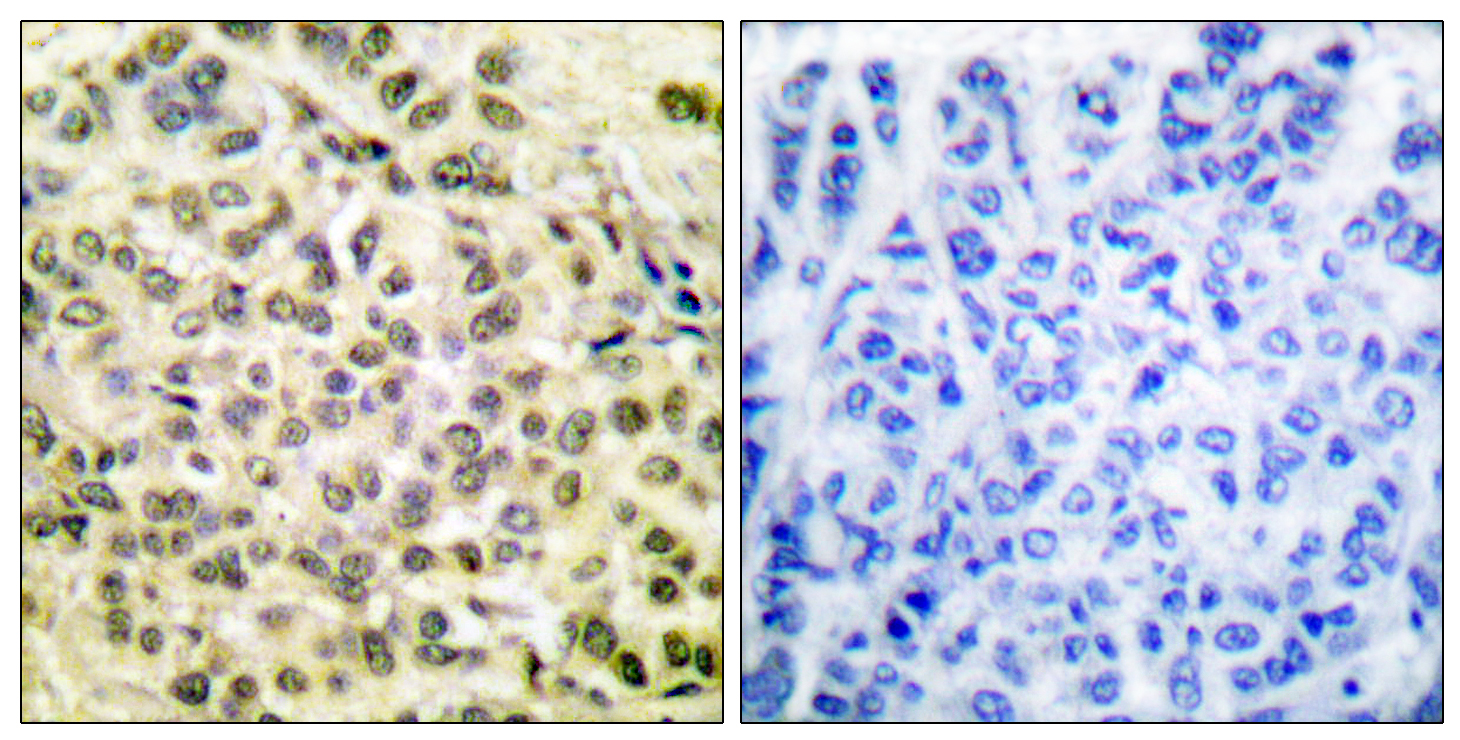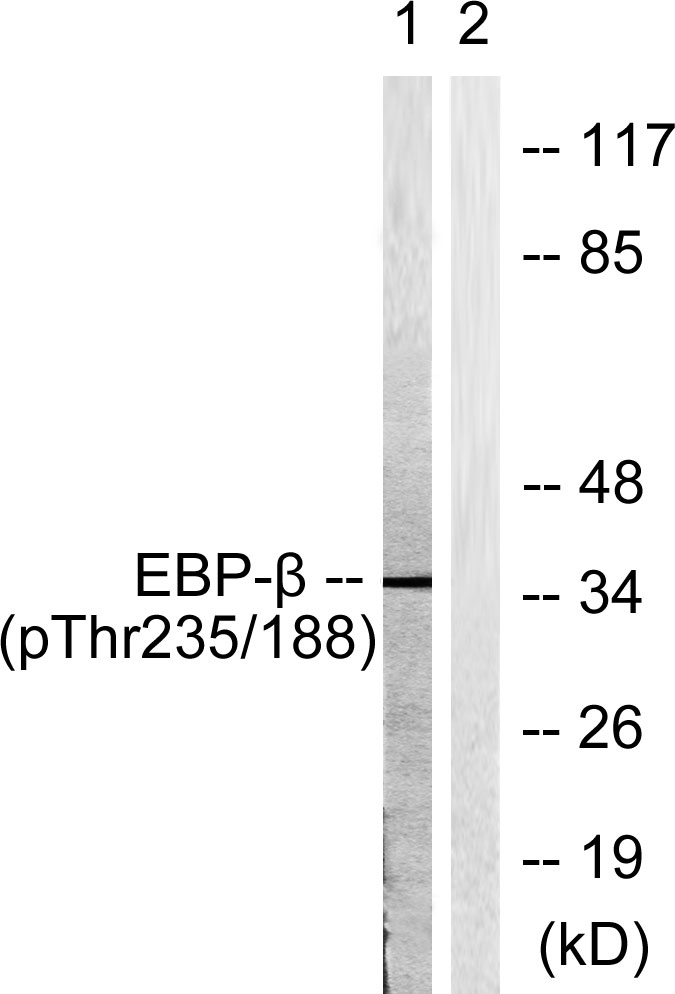C/EBP β (phospho Thr235) Polyclonal Antibody
- Catalog No.:YP0040
- Applications:WB;IHC;IF;ELISA
- Reactivity:Human;Mouse;Rat
- Target:
- C/EBP β
- Fields:
- >>IL-17 signaling pathway;>>TNF signaling pathway;>>Tuberculosis;>>Transcriptional misregulation in cancer
- Gene Name:
- CEBPB
- Protein Name:
- CCAAT/enhancer-binding protein beta
- Human Gene Id:
- 1051
- Human Swiss Prot No:
- P17676
- Mouse Gene Id:
- 12608
- Mouse Swiss Prot No:
- P28033
- Rat Gene Id:
- 24253
- Rat Swiss Prot No:
- P21272
- Immunogen:
- The antiserum was produced against synthesized peptide derived from human C/EBP-beta around the phosphorylation site of Thr235/188. AA range:201-250
- Specificity:
- Phospho-C/EBP β (T235) Polyclonal Antibody detects endogenous levels of C/EBP β protein only when phosphorylated at T235.
- Formulation:
- Liquid in PBS containing 50% glycerol, 0.5% BSA and 0.02% sodium azide.
- Source:
- Polyclonal, Rabbit,IgG
- Dilution:
- WB 1:500 - 1:2000. IHC 1:100 - 1:300. IF 1:200 - 1:1000. ELISA: 1:10000. Not yet tested in other applications.
- Purification:
- The antibody was affinity-purified from rabbit antiserum by affinity-chromatography using epitope-specific immunogen.
- Concentration:
- 1 mg/ml
- Storage Stability:
- -15°C to -25°C/1 year(Do not lower than -25°C)
- Other Name:
- CEBPB;LAP;TCF5;PP9092;CCAAT/enhancer-binding protein beta;C/EBP beta;Liver activator protein;Nuclear factor NF-IL6;Transcription factor 5;TCF-5
- Observed Band(KD):
- 36kD
- Background:
- This intronless gene encodes a transcription factor that contains a basic leucine zipper (bZIP) domain. The encoded protein functions as a homodimer but can also form heterodimers with CCAAT/enhancer-binding proteins alpha, delta, and gamma. Activity of this protein is important in the regulation of genes involved in immune and inflammatory responses, among other processes. The use of alternative in-frame AUG start codons results in multiple protein isoforms, each with distinct biological functions. [provided by RefSeq, Oct 2013],
- Function:
- function:Important transcriptional activator in the regulation of genes involved in immune and inflammatory responses. Specifically binds to an IL-1 response element in the IL-6 gene. NF-IL6 also binds to regulatory regions of several acute-phase and cytokines genes. It probably plays a role in the regulation of acute-phase reaction, inflammation and hemopoiesis. The consensus recognition site is 5'-T[TG]NNGNAA[TG]-3'.,PTM:Sumoylated by polymeric chains of SUMO2 or SUMO3.,similarity:Belongs to the bZIP family.,similarity:Belongs to the bZIP family. C/EBP subfamily.,similarity:Contains 1 bZIP domain.,subunit:Binds DNA as a dimer and can form stable heterodimers with C/EBP alpha, delta and gamma. Interacts with TRIM28 and PTGES2.,tissue specificity:Expressed at low levels in the lung, kidney and spleen.,
- Subcellular Location:
- Nucleus . Cytoplasm . Translocates to the nucleus when phosphorylated at Ser-288. In T-cells when sumoylated drawn to pericentric heterochromatin thereby allowing proliferation (By similarity). .
- Expression:
- Expressed at low levels in the lung, kidney and spleen.
- June 19-2018
- WESTERN IMMUNOBLOTTING PROTOCOL
- June 19-2018
- IMMUNOHISTOCHEMISTRY-PARAFFIN PROTOCOL
- June 19-2018
- IMMUNOFLUORESCENCE PROTOCOL
- September 08-2020
- FLOW-CYTOMEYRT-PROTOCOL
- May 20-2022
- Cell-Based ELISA│解您多样本WB检测之困扰
- July 13-2018
- CELL-BASED-ELISA-PROTOCOL-FOR-ACETYL-PROTEIN
- July 13-2018
- CELL-BASED-ELISA-PROTOCOL-FOR-PHOSPHO-PROTEIN
- July 13-2018
- Antibody-FAQs
- Products Images

- Western Blot analysis of various cells using Phospho-C/EBP β (T235) Polyclonal Antibody diluted at 1:500

- Immunohistochemical analysis of paraffin-embedded Human lung cancer. Antibody was diluted at 1:100(4° overnight). High-pressure and temperature Tris-EDTA,pH8.0 was used for antigen retrieval. Negetive contrl (right) obtaned from antibody was pre-absorbed by immunogen peptide.

- Enzyme-Linked Immunosorbent Assay (Phospho-ELISA) for Immunogen Phosphopeptide (Phospho-left) and Non-Phosphopeptide (Phospho-right), using C/EBP-beta (Phospho-Thr235/188) Antibody

- Immunofluorescence analysis of HepG2 cells, using C/EBP-beta (Phospho-Thr235/188) Antibody. The picture on the right is blocked with the phospho peptide.

- Immunohistochemistry analysis of paraffin-embedded human breast carcinoma, using C/EBP-beta (Phospho-Thr235/188) Antibody. The picture on the right is blocked with the phospho peptide.

- Western blot analysis of lysates from HepG2 cells treated with EGF 200ng/ml 30', using C/EBP-beta (Phospho-Thr235/188) Antibody. The lane on the right is blocked with the phospho peptide.



